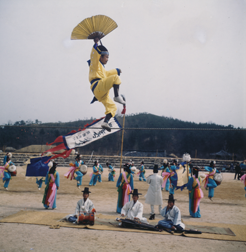과천의 문화> 줄타기
줄타기
줄타기(유네스코 인류무형문화유산)

【그림】기산풍속도
줄타기는 예로부터 우리나라에 전하여 오는 민간 연희 중 하나로, 다른 연희 종목들과는 달리 고도의 전문적인 기술과 재주가 필요한 기예이다.
한국에서 줄타기가 언제부터 공연되었는지 정확한 시대는 알 수 없으나 신라시대부터 시작된 팔관회의 전통을 잇는 조선 시대의 나례(儺禮)에서 줄타기가 행해졌다는 기록이 있다. 조선 시대의 학자 성현(成俔, 1439~1504)은 자신이 지은 시에서 "走索還同飛燕輕(주삭환동비연경, 날아가는 제비와 같이 가볍게 줄 위에서 돌아간다)"이라며 줄타기를 묘사하기도 하였다. 조선 시대까지 줄타기는 궁중에서도 공연되었고, 관이나 민간의 잔치에서도 행해졌다.
동국세시기에 의하면 옛날 한양에서는 정월 보름 저녁에 종이 울리면 사람들이 거리로 나와 다리밟기를 했는데, 사람들이 너무 많아서 혼잡을 이루었다고 한다. 같은 마을의 젊은 패들이 집단으로 하거나, 같은 직업을 가진 사람들이 때를 지어 다리밟기를 할 때에는 노래도 부르고 춤도 추면서 혼잡한 가운데 여흥으로 기분을 돋우는 일도 있었다.
여기에서 다리밟기는 답교놀이로 발전을 하게 되었다. 답교놀이는 일정한 절차가 있는 것이 아니라, 농악을 치거나 여기에 맞추어 노래하고 춤추며 군중과 함께 즐기는 것이다. 농악을 치며 마을 사람들이 모여 즐기는 이 두 놀이가 합쳐지면서, 명칭도 무동놀이가 포함된 답교놀이라는 뜻의 무동답교놀이라 불려지게 되었다. 현재의 공연을 보면 무동마당과 답교마당이 뚜렷하게 구분되지 않고 무동놀이가 진행되는 체로 답교놀이가 이루어지는 것을 알 수 있다.
그러나 무동놀이는 시간적인 구애를 받지 않지만 답교놀이는 정월 보름에 하는 시간적인 제약이 있는 놀이이므로 무동놀이가 포함된 답교놀이라는 뜻으로 보는게 맞다고 하겠다. 무동답교놀이라는 명칭이 공식적으로 쓰이기 시작한 것은 민속학자 심우송씨와 과천 노인들에 의해 다시 재연되면서부터였고, 1982년 전국민족예술경연대회에 참가하면서부터 일반인에게 알려지게 되었다.
줄타기에 참여하는 이는 줄광대와 어릿광대, 삼현육각재비(피리가 둘, 대금, 해금, 장구, 북이 각각 하나씩 편성되는 풍류의 연주자)들로 편성된다. 줄광대는 줄 위에서 다양한 기술과 재주, 재담을 선보이고, 어릿광대는 땅 위에 서서 줄광대와 재담을 나누며, 삼현육각재비들은 줄 밑의 한편에 앉아 음악을 연주한다. 삼현육각재비들은 장구, 피리, 대금, 해금 등을 연주하면서 광대와 관중의 흥을 돋우며, 광대들의 동작을 더 역동적이고 극적으로 만든다. 줄타기 공연에 참여하는 구성원에서 알 수 있듯이, 한국의 전통 줄타기는 단지 줄 위에서 펼치는 곡예 기술에만 초점을 맞추는 다른 나라의 줄타기와는 다르다. 즉, 줄 위에서 펼치는 곡예 기술에 더하여 재담과 음악, 연극적 요소들이 한데 어울려 펼쳐지는 종합 예술로 볼 수 있다.
줄이 설치되면 줄광대와 어릿광대가 줄 앞에 상을 차려놓고 안전하게 줄을 탈 수 있게 천지신명께 기원하는 '줄고사'를 치른다. 이를 마친 후 줄광대는 줄 위에 올라서서 다양한 기예를 펼치고 재담을 늘어놓으며 관중을 즐겁게 한다. 줄 위에 올라갈 때 줄광대는 손에 부채를 들거나 수건을 든다. 이는 동작을 멋있게 하려는 것이기도 하지만 이로써 몸의 균형을 잡기 위함이기도 하다. 즉, 부채는 바람을 일으키고 또 막을 수도 있어서 몸을 가누는 데 매우 유용하며, 한편으로 우아하고 멋있는 동작을 표현하는 데에도 사용된다.
줄광대가 줄 위에서 펼치는 다양한 재주를 '잔노릇'이라고 하는데, 이는 30여가지가 넘는다. 줄 위에서 걸어가는 것이 가장 기본적인 동작이며, 뒤로 걸어가거나 한 발로 뛰고, 걸터앉거나 드러눕기도 한다. 때로는 재주를 넘다가 떨어지는 척해서 관객들을 놀라게 하고, 익살을 부려 관중을 즐겁게도 한다. 이러한 줄광대의 모든 동작은 삼현육각재비들이 반주하는 전통적인 장단 (염불, 타령, 당악 )에 맞추어 행해지는데, 이는 우리나라 전통 줄타기의 특징 중 하나이다.
여기에 줄타기의 재미를 더하는 것은 풍자와 해학을 담은 재담이다. 줄광대는 단순히 줄만 타는 것이 아니라 어릿광대와 대화를 주고받으며, 갖가지 이야기를 소리와 연극적인 구성으로 엮어서 익살을 떤다. 전통적인 연주곡목인 '중타령 ', '새타령 ', '팔선녀타령 ', '왈자타령 ' 등 파계승과 타락한 양반을 풍자한 이야기를 비롯하여, 관객들의 다양한 모습을 흉내내는 등 삼현육각이 연주하는 장단에 맞추어 이야기를 풀어가며 관객들을 웃긴다. 이처럼 한국의 전통적인 줄타기는 줄을 타는 곡예 기술에만 머무르지 않고, 노래와 재담, 연극적 요소 등을 곁들여 줄 타는 사람과 구경꾼이 함께 어우러진 놀이판을 이끄는 점이 특징이다.
재담이 끝나고 줄타기가 마무리되는 단계에서는 '살판'을 벌이는데, 이 때 줄광대는 허공에서 몸을 날려 재주를 넘은 다음 다시 줄에 앉는다. 살판은 줄타기 기술 중에서도 제일 위험하고 고도의 기술이 필요한 동작이기 때문에 줄광대는 살판을 하기에 앞서 "잘하면 살판이요, 잘못하면 죽을 판 "이라는 재담을 늘어놓기도 한다. 이 살판이 끝나면 줄타기 공연도 끝이 난다.

【사진】김영철선생 공연
줄타기는 1976년 중요무형문화재로 지정되었으며, 당시 줄광대였던 김영철 (1920 ~1988 )이 예능보유자로 인정되어 전승되어 왔다. 그가 타계한 뒤에는 그의 제자였던 김대균이 2000년에 예능보유자로 인정되어 현재까지 줄타기의 명맥을 이어 가고 있다. 김대균을 중심으로 구성된 줄타기보존회는 다양한 공연과 교육 프로그램을 운영하면서 전통 공연 예술인 줄타기를 널리 알리고 전승하고자 힘쓰고 있다. 줄타기는 2011년 인류무형유산 대표 목록에 등재되어 인류가 보호하고 전승해야 할 무형유산으로 재조명 받고 있다.
줄타기의 본향 과천
Jultagi, tightrope walking
Jultagi, Korean traditional tightrope walking is both a performance art and entertainment that is accompanied by narrating funny stories, singing, dancing, and performing various acrobatic feats on a single thin rope. Jultagi is a traditional folk entertainment that is different from other forms of entertainment because it requires highly trained, professional technique and skill.
Although it is unclear as to when jultagi originated in Korea, a record shows that it took place during the Joseon Dynasty (1392~1910) at narye, a transmission of palgwanhoe (Buddhist ceremony) of the Silla Dynasty. Scholar Seong hyeon (1439~1504) of the Joseon Dynasty described jultagi in his poem as, 'light movements on the rope like a flying swallow'. Jultagi during this era took place not only in the palace, but also in government offices or commoners’ festivals.
Jultagi consists of a Jul-gwangdae (tightrope walker), an Eolit-gwangdae (earthbound clown), and a team of musicians called samhyeonyukgak jaebi (musicians performing two piri (Korean flute), a daeguem (transverse bamboo flute), a haeguem (Korean fiddle), a janggu (an hourglass shaped drum), and a buk (bass drum). The tightrope walker performs various feats, techniques, and witty talk on the rope while the earthbound clown engages in a joking banter and the musicians play music on the ground. The team of musicians entertains the audience and dramatizes the clowns’ movements with its hourglass drum, flute, fiddle, bass drum, and other instruments. As can be seen in the participants of tightrope walking, Korea’s traditional tightrope walking is different from that in other countries which focus only on acrobatic skill. In other words, it is seen as a synthetic art that combines acrobatic skill with narration, music, and drama.
The rope used in tightrope walking has traditionally been made with hemp and is approximately 3cm thick. The hemp is made into a string, carefully pruned, and twisted like a straw rope. The straw rope is folded into three strands and twisted again. This rope is tied to a jaksumok, a strong log that is erected crossways, and is connected to each end. Although there is no standard height of the rope, it is usually 3m high and approximately 10m long.
Once the rope is fixed, the tightrope walker and the earthbound clown set a table with offerings and begin the julgosa. Julgosa is a ritual held to wish for an accident-free performance. After the ritual, the tightrope walker goes up on the rope and entertains the audience with various feats and banter. When going up on the rope, the tightrope walker always holds a hand fan or a towel. This is not only to make the movements look fancier, but also to help maintain his balance on the rope. Used in expressing elegant movements, the hand fan is also extremely useful in keeping balance as it can either create or block wind.
The various feats performed by the tightrope walker are called jannoreut. There are over 30 kinds of jannoreut which include the most basic movement of walking straight, walking backwards, jumping on one foot, sitting astride, or lying down on the rope. At times, the tightrope walker pretends to fall down while performing a fest to surprise the audience or acts like a clown to humor the spectators. All the movements of the tightrope walker are performed with the traditional music played by the samhyeon yukgakiaebi, which is one of the unique characteristics of Korean tightrope walking.
The witty banter filled with satire and humor is another element that adds on to the entertainment of jultagi. The tightrope walker does not only perform on the rope, but also exchanges dialogue with the earthbound clown and tells a story using various sounds and drama. Traditional pieces such as jungtaryeong saetaryeong, palseonnyu taryeong, and walja taryeong that satirize corrupt aristocrats or monks, entertain the audience along with the music performed by the samhyeon yukgakjaebi. Korea’s jultagi does not focus only on acrobatic feats. Rather, it creates a stage in which the performers and audience come together by bringing forth music, witty dialogue, and dramatic elements. Salpan refers to a technique that takes place when the banter ends and the tightrope walker is about to come down. This is when the tightrope walker throws himself in the air, performs an acrobatic fest, and sits back down on the rope. Salpan requires the most dangerous and highly-trained technique in jultagi, which is why some joke that it is only salpan (able to live) if you’re good, but jugelpan (about to die) if you’re not. Once the salpan is over, the jultagi performance comes to an end.
Jultagi has been designated as an Important Intangible Cultural Heritage in 1976 when the tightrope walker at that time, Kim Yeong-chul (1920~1988) was the skill holder. When he passed away, his pupil, Kim Dae-gyun was recognized as the skill holder in 2000 and continues to preserve the jultagi tradition to this day. The Jultagi Safeguarding Association centered on Kim Dae-gyun strives to spread and hand down the traditional performance art through holding various performances and educational programs. Inscribed on the Representative List of the Intangible Cultural Heritage of Humanity in 2011, jultagi is recognized as an intangible cultural heritage that needs to be protected and preserved by all humanity.
綱渡り
綱渡りは昔から我が?に?わっており、民間宴?の中の一つとして、他の宴?の種目とは違い、高度の?門的技術と才能が必要とされる技芸である。
韓?で綱渡りがいつから公演されていたのか、正確な時代はわからないが、新羅時代から始まった八關會(高麗時代、中京と西京で土俗神に祭祀を行った儀式)の?統を?承している朝鮮時代の儺禮で、綱渡りが行われるようになったという記?がある。
朝鮮時代の?者(成俔, 1439~1504)は自身が作った詩で "走索還同飛燕輕,(飛ぶ燕の如く??と綱の上で?還したり)"という句があり、綱渡りを 描?している。朝鮮時代まで綱渡りは宮廷でも公演されており、官や民間の儀式でも行われた。
綱渡りに??する者は、綱渡り芸人や道化師、三絃六角才備(小笛が二つ、大笛、?琴,大太鼓、小太鼓がそれぞれ一つずつからなる風流の演奏者達)で編成された。綱渡り芸人は綱の上で多?な技術と才能、才談を披露し、道化師は地上に立ち、綱渡り芸人と才談を交わし、三絃六角才備達は綱の下の一方に座り、音?を奏でる。三絃六角才備達は大太鼓、小笛、大笛、?琴,等を演奏しながら芸人と?衆の興味をかき立て、芸人達の動作をより躍動的で劇的に引きたてる。綱渡りは公演に??する構成員からもわかるように、韓?の?統綱渡りは?に綱の上で繰り?げる曲芸の技術だけに焦点を?てた他の?の綱渡りとは異なる。すなわち、綱の上で繰り?げる曲芸の技術に加え、才談と音?、演劇的要素等が、ひと所に調和され、繰り?げられる?合芸術とも言える。
?統的な綱渡りで使用される綱は麻で作られており、太さは約2.7cm程度であった。麻を?の形態にこしらえ、これを丹念に整え、小綱のように引っ張った後、三重に重ねて?をない、綱を作るのである。この綱は‘ジャクスウ木’と呼ばれる、すれ違いに立てかけた堂?とした丸太に結び、?側に連結する。綱の高さはまちまちだが、およそ3m程度で長さは10mくらいになる。
綱が設置されると綱渡り芸人と道化師が綱の前に御膳を備え置き、安全に綱渡りが出?るよう天地神明に祈願する'綱祈願'を執り行なう。これを終えた後、綱渡り芸人は綱の上に立ち、多?な技芸を繰り?げ、才談を交わしながら?衆を?しませる。綱の上に登る時に綱渡り芸人は手に?扇や手拭を持つ。これは動作を見?え良くしようという意?もあるが、これにより身?の均衡を?むためとも言われる。すなわち?扇は風を起こし、また防ぐことも出?るので、身?を支えるのにとても有用であり、一方では優雅で見?え良く動作を表現する?にも使用される。
綱渡り芸人が綱の上で繰り?げる多?な技を‘チャンノルッ’と言われるが、これは 30余種類を越える。綱の上で?くことが一番の基本的な動作であり、後方に?いたり、一?踏み?んで飛び跳ね、座り?んだり??んだりもする。時には踏み外して落ちるふりをして?客達を驚かせたり、おどけて?衆を?しませたりもする。このような綱渡り芸人の全ての動作は三絃六角才備達が伴奏する?統的拍子(念?、打令、唐?)に合わせて行うが、これは我が?の?統綱渡りの特?のうちの一つである。
綱渡りの面白さをもっと引きたてるのは、風刺とこっけいさを?めた才談である。綱渡り芸人は?純に綱にだけ?るのではなく、道化師と?話のやり取りしながら ??な話を?と演劇的な構成で組み?み、おどけてみせる。?統的な演奏曲目である'僧 打令', '鳥 打令', '八仙女 打令', '曰字 打令'等、破戒僧や?落した?班を風刺した話を始めとし、?客達の多?な姿を?似る等、三絃六角が演奏する拍子に合わせ、話をひも解いて行きながら?客達を笑わせる。 このように韓?の?統的な綱渡りは、綱に?る曲芸、技術にばかりとどまらず、歌と才談、演劇的要素等を組み入れ、綱に?る者と見物人が一?となった遊びの場に導く点が特?である。
才談が終わり、綱渡りが締めくくられる段階では‘サルパン’を繰り?げるが、この時綱渡り芸人は空中から身?を投げ出して技を超えた芸を披露した後、再び綱の上に座る。サルパンは綱渡り技術の中でも最も危?で高度な技術が必要な動作であるため、綱渡り芸人は生きる場を行う前に "上手くいけばサルパン(生きる場の意)、まかり間違えばチュグルパン(死の場)"という才談を述べたりする。このサルパンが終われば綱渡りの公演も終わりとなる。
綱渡りは1976年、重要無形文化財として認定され、?時綱渡り芸人であったキム?ヨンチョル(1920~1988)が、この芸能保有者として認定された後も?承されてきた。彼が他界した後は彼の弟子であったキム?デギュンが2000年に芸能保有者として認定され、現在まで綱渡りの命脈を?いでいる。キム?デギュンを中心に構成された綱渡り保存?は、多?な公演と?育プログラムを運?しながら?統公演芸術である綱渡りを?く知らせ、?承していこうと?力している。 綱渡りは2011年、ユネスコ人類無形遺産代表目?に登載され、人類が保護して?承すべく無形遺産として再び評?されている。



